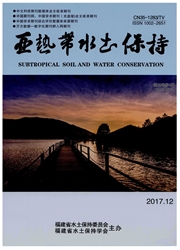

 中文摘要:
中文摘要:
南方花岗岩红壤侵蚀区生态系统退化的研究集中在侵蚀的过程模拟与预测、土壤退化成因和生态恢复与重建等方面,关于植被净第一性生产力对退化生态系统评估的研究还较少。本研究选取朱溪小流域气象数据,结合Spot一5卫星遥感数据和DEM(数字高程模型),构建朱溪流域植被净第一性生产力(Net Primary Pro—duetivity,NPP)的CASA(Camegie—Ames—Stanford Approach)模型,进行朱溪小流域NPP估算。结果表明:①朱溪小流域的NPP分布整体上呈现出低值水平,平均值仅为24.04g/m2·mon,标准差高达9.78。②经过近15年的强化治理,朱溪小流域NPP空间上呈现出:西部和东部地区NPP值较大;中部地区NPP显著改善,部分地区仍需强化治理。③NPP的空间分布具有明显的带状分布:NPP在270—320m呈现较高值区,生态环境较好;NPP在320-470m呈现低值带,生态环境破碎化严重;NPP在470~680m呈现高值区,植被生长良好,生态环境良好。④林地、园地、农田等经济用地的NPP值较高且均匀分布,其中一级土地利用类型NPP值大小顺序为:耕地〉草地〉林地〉园地〉未利用地,二级土地利用类型NPP值大小顺序为:耕地〉天然草地〉有林地〉苗圃〉果园〉茶果间作园〉疏林地〉荒草地〉迹地。人为干预痕迹显著,二级土地类型的空间变异程度:耕地〉茶果间作〉果园〉苗圃〉有林地〉荒草地〉疏林地〉迹地。
 英文摘要:
英文摘要:
At the moment, researches of ecosystem degradation in the eroded granite red soil areas of South China are focused on erosion simulation and prediction, soil degradation causes and aspects of ecological restoration and recon- struction. However, there is less concern on the study of vegetation net primary productivity of degraded ecosystem re- sponse. Based on meteorological data, Spot- 5 satellite remote sensing data and DEM (digital elevation model), it is constructed the Zhuxi Small Watershed CASA ( Carnegie - Ames - Stanford Approach) model to estimate the NPP. The results show that : (1)NPP distribution is at low level in the whole small watershed of Zhu Xi, with the average value of 24.04 g/( m2 · Moll), that the standard deviations is up to 9.78 ; (2)after nearly 15 years of strong governance, the NPP value distribution on space in the Zhuxi watershed appeared as higher in the eastern and the western regions,and significantly improved in the central region, but the governance still need to be strengthened in some areas; (3) stripped distribution of NPP, that the NPP value at 270 ~ 320m is higher, with better ecological enviromnent while the NPP value at 320 - 470m is lower, with worse ecological environment. In addition, the NPP value at 470 - 680m is the highest with good vegetation and better ecological environment; and (4) NPP value is high and evenly distributed in the economic land use such as woodland, garden and farmland, etc. Of which, the NPP values at the first - level land -use types are listed as farmland 〉 grassland 〉 woodland 〉 garden 〉 vacant land, and at the second -level land use types are listed as arable land 〉 natural grassland 〉 woodland 〉 nursery 〉 orchard 〉 tea- fruit intercropping orchard 〉 sparse woodland 〉 desert grassland 〉 slash. Since the human intervention footprint is obvious, the spatial variation of the NPP values at second - level land use types are listed as farmland 〉 tea - fruit intercropping land 〉 orchard 〉
 同期刊论文项目
同期刊论文项目
 同项目期刊论文
同项目期刊论文
 期刊信息
期刊信息
